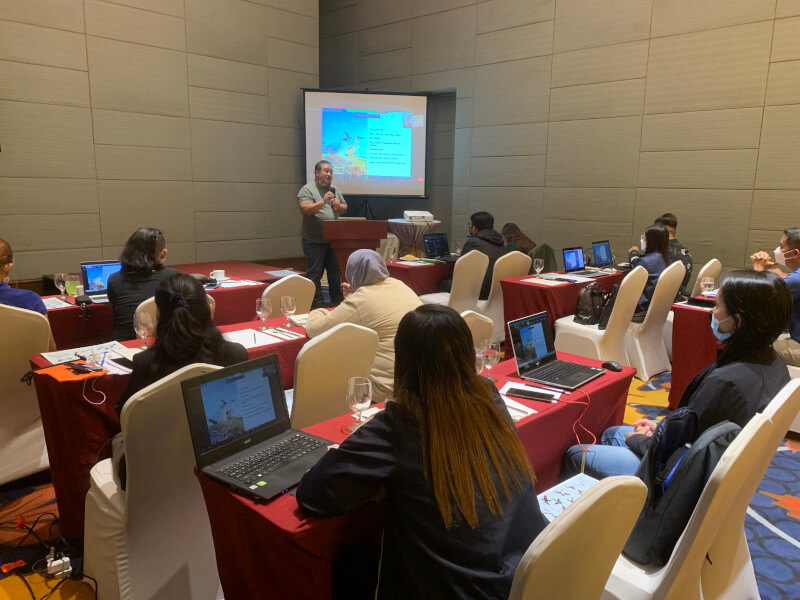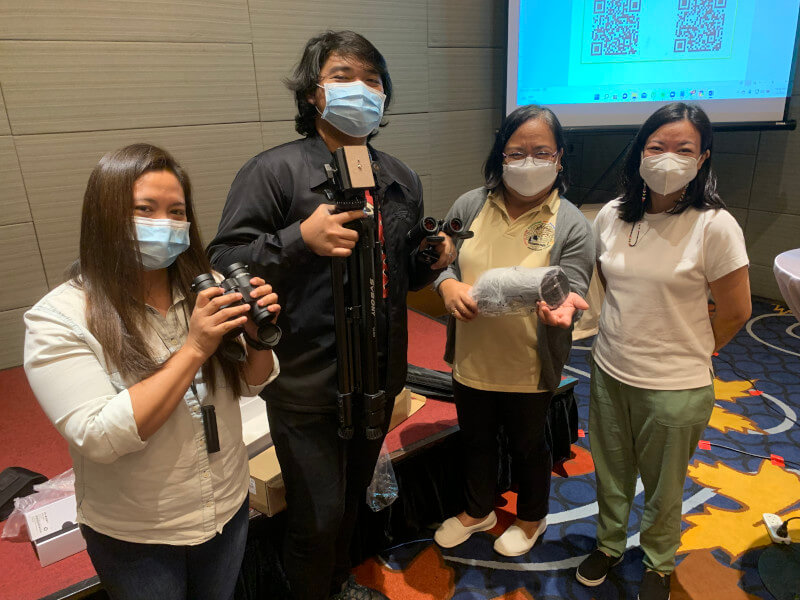
In the effort to increase our knowledge and capacities in conserving seabirds in the Philippines, the Biodiversity Management Bureau of the Department of Environment and Natural Resources, Isla Biodiversity Conservation, partnering with the Tubbataha Management Office, Wetlands International, Marine Wildlife Watch of the Philippines, and Philbio, organized the 1st National Seabird Identification and Monitoring Training Workshop last 20-22 July 2022 through a hybrid event in Quezon City and online via Zoom.
This activity is a follow-up to the National Seabird Forum and Action Planning Workshop virtually held in October 2021 (link) , the result of which is currently being translated into the National Seabird Action Plan for 2022–2026. The 5-year National Seabird Action Plan aims to assess and evaluate 100 confirmed and potential seabird sites to have a better understanding of the distribution and status of seabirds in the country. Further, the action plan recognized the main challenges of seabird research and conservation in the Philippines, including the lack of skills in seabird identification even among field staff and conservation practitioners, and the lack of knowledge to monitor and assess seabirds and their habitats.
The 1st National Seabird Identification and Monitoring Training Workshop aimed to address these gaps. The training workshop had two specific objectives: 1) Provide field managers with the skills to effectively identify and monitor seabirds; and 2) Identify target sites for seabird monitoring in the Philippines in 2023.
The first part of the program aimed at introducing the seabirds, their habitat, distribution, and the threats to their population through a presentation by Mr. Arne E. Jensen, Associate Expert from Wetlands International. Mr. Jensen highlighted the 35 priority seabird species and their status in the Philippines. The lecture by Dr. Juan Carlos T. Gonzalez, a Professor from the University of the Philippines, ran through the different seabird physical traits useful for identifying seabirds in the field. The next set of presentations focused on the different seabird monitoring methodologies, depending on the habitat type being surveyed: Ms. Retch Alaba, Research Officer of the Tubbataha Management Office, presented the survey methodologies they employ in monitoring the seabirds of Tubbataha Reefs. Dr. JC Gonzalez, meanwhile, shared methods for surveying rocky islets. This was followed up by a sharing of experience from Ms. Kathy Cielo from the Mindoro Biodiversity Conservation, who has recently surveyed the Apo Reef. Cynthia Layusa from Isla Biodiversity Conservation shared survey methods employed on open seas. Later, she shared the forms adapted from the Asian Waterbird Census and modified for seabirds: seabird habitats and threats assessment form, and a seabird census form. These forms are intended for field use and can provide baseline data on seabirds, especially in sites that have yet to be surveyed, or where long-term seabird monitoring is in place.
Next, a case study of exemplary site management was shared by Ms. Angelique Songco, Park Superintendent of the Tubbataha Reefs Natural Park. Ms. Songco presented their multi-disciplinary approach to conserving the park—from roost supplementation and reforestation to capacity building of rangers and other stakeholders. Cynthia Layusa likewise shared the results of a pilot survey that determines the knowledge and perception of local fisherfolks on seabirds. She also shared insights on how the results can be used in developing information and educational materials, capacity-building activities, and local community outreach.
The second part of the event is a workshop to identify sites for seabird census or survey. The goal was to contribute to the assessment of 100 known or potential seabird sites in the country. Ultimately, the site assessments will help inform the priority sites for long-term seabird monitoring and conservation and will form the network of seabird sentinel sites in the Philippines. The participants named potential and verified seabird sites per region in the Philippines, and identified the activities, partners, and budgetary needs for these. At the end of the workshop, we produced a list of sites for surveys in the next 1-2 years, and within 3-5 years. We also discussed the support coming from the national level and NGOs, such as procuring equipment for communities and local offices, developing field guides and monitoring manuals, designing capacity-building activities, and tapping partners, experts, and external funding sources. It was assured that partnership and collaboration among the Biodiversity Management Bureau and the seabird core group will continue and will extend assistance to the regions and communities needing technical support and expertise.
The event was attended by over 100 participants representing national and regional DENR offices, marine protected areas (MPAs), NGOs, and universities from across the Philippines. We are thankful for the support of the East Asian-Australasian Flyway Partnership small grants program.
To access the PDFs of the presentations delivered during the 1st National Seabird Identification and Monitoring Training and Workshop, visit the Seabirds PH google site https://sites.google.com/view/seabirdsph/seabird-resources or email at seabirds.ph@gmail.com. To inquire about the project or how you could help, or if you have suggestions on improving the draft seabird census form and the habitat and threat assessment form, please email cynthia@isla.org.ph

© Isla Biodiversity Conservation

© Isla Biodiversity Conservation
Prepared by:
Cynthia Adeline A. Layusa
Isla Biodiversity Conservation
www.isla.org.ph
The project was funded through the 2021 EAAFP WG/TF Small Grant Fund. View the report, Click here.




